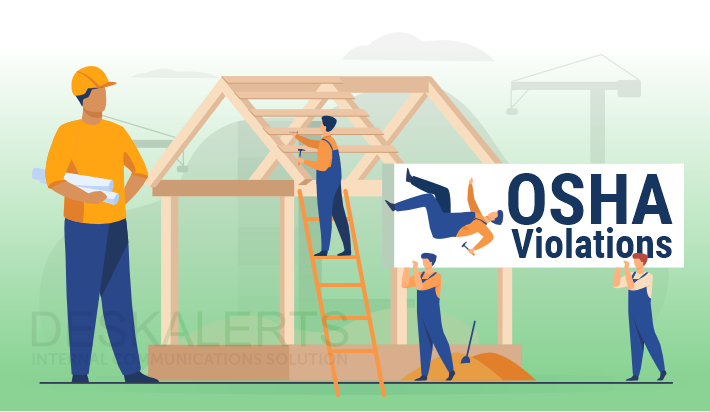16 min read
How IT Teams Keep Everyone Informed During Outages: Comms Solutions That Work
Teams is down. Tickets to the help desk flood in faster than anyone in the IT team can triage. Email is useless because half the staff can't sign...
6 min read
 Milana Graf
:
Oct 24, 2024
(Updated : Sep 29, 2025)
Milana Graf
:
Oct 24, 2024
(Updated : Sep 29, 2025)

Preventing workplace safety risks involves identifying hazards, implementing effective policies, and using tools like DeskAlerts to communicate with employees instantly. With real-time notifications, you can warn staff of dangers, share safety updates, and reduce accidents.
In this article, we explore common workplace safety issues, the consequences of neglecting safety protocols, and solutions that can mitigate risks. We also highlight how modern communication tools like DeskAlerts can enhance safety initiatives by providing real-time alerts and compliance management.
Table of Contents
1. The Common Pain Points in Workplace Safety
2. The Consequences of Ignoring Workplace Safety
3. Data-Driven Solutions for Improving Workplace Safety
4. The Role of DeskAlerts in Supporting Workplace Safety
Workplace safety is a critical component of any successful business. Failing to implement proper safety measures can lead to serious injuries, increased operational costs, and damage to the company’s reputation. Despite advances in technology and safety protocols, workplace hazards remain prevalent across industries. According to the Bureau of Labor Statistics (BLS), there were 2.8 million nonfatal workplace injuries reported in private industries in 2022, with thousands more going unreported. Addressing these incidents through preventive measures, regular safety training, and effective communication is essential for maintaining a safe and compliant work environment.
Workplace safety is one of the most significant challenges businesses face, particularly when they fail to recognize and address potential risks before accidents occur. Common hazards, such as improper ergonomics, electrical hazards, and unmaintained fire safety equipment, often go unnoticed until an incident happens. For example, unergonomic office setups can cause long-term musculoskeletal issues for employees, while faulty electrical systems can lead to severe injuries or fires. Identifying and mitigating these risks in advance is key to maintaining a safe and productive work environment.
Without regular safety audits and proactive risk assessments, these issues can escalate into accidents, injuries, and costly downtime for businesses.
Another major pain point is the lack of employee engagement with safety protocols. According to industry reports, 40% of workplace injuries are linked to employees disregarding or failing to follow established safety procedures. This lack of compliance can stem from inadequate training, outdated safety practices, or a failure to engage employees in safety conversations.
When employees are not actively involved in safety initiatives, they may become complacent, putting themselves and their colleagues at risk.
In emergency situations, such as fires, chemical spills, or severe weather, response time is critical. However, many companies struggle with delivering timely emergency alerts to all employees, especially in large or multi-site organizations. A delay in notifying employees about potential dangers can lead to confusion, panic, and greater injury risks during evacuations or emergency procedures.
The key challenge is ensuring that all employees receive clear, immediate instructions during emergencies, regardless of their location or role within the organization.
Failure to comply with OSHA standards can have serious financial and legal consequences. OSHA violations not only endanger employees but also expose companies to fines that can reach up to $161,323 per violation in 2024. Non-compliance with safety regulations can result from insufficient training, inadequate safety equipment, or lack of safety audits.
Beyond financial penalties, repeated violations can damage a company’s reputation, making it harder to retain employees and attract new talent.
Neglecting workplace safety can significantly increase the likelihood of injuries. According to the BLS 2022 Report, there were over 907,000 occupational injuries that resulted in employees taking time off from work. The most common types of injuries included sprains, strains, fractures, and overexertion injuries, many of which could have been prevented with better safety measures.
Frequent injuries not only affect employee health but also disrupt business operations, causing lost workdays and lowered productivity.
Unsafe workplaces lead to increased workers’ compensation claims, putting significant financial strain on businesses. According to the National Safety Council, U.S. employers spend more than $1 billion per week on direct workers’ compensation costs. These costs include medical expenses, rehabilitation, and lost wages, which can quickly add up for companies that don’t prioritize safety.
Investing in preventive safety measures can reduce workers’ compensation claims, ultimately saving businesses money in the long run.
Employees who feel unsafe in their work environment are more likely to leave their job, leading to higher turnover rates.
According to the PwC Global Workforce Hopes and Fears Survey 2022, 65% of employees would consider leaving their jobs if they felt unsafe at work. Creating a culture of safety not only protects employees but also helps retain talent and foster a more engaged and productive workforce.
One of the most effective ways to address workplace safety issues is through regular risk assessments and safety audits. By proactively identifying and addressing potential hazards, businesses can prevent accidents before they occur. These assessments should cover common risk areas such as ergonomics, electrical hazards, fire safety, and mental health risks. According to OSHA, companies that perform routine safety audits are 50% less likely to experience serious workplace injuries.
Implementing regular audits ensures that safety measures are up to date and that employees remain aware of best practices. Businesses can partner with third-party experts or train internal teams to carry out these audits regularly.
Providing continuous safety training for employees is critical for ensuring compliance with safety protocols. A report by the National Safety Council found that businesses with frequent, updated safety training sessions experienced a 32% reduction in workplace injuries. This includes not only general safety training but also specific training tailored to the unique risks associated with different roles.
Involving employees in safety discussions and decision-making processes, such as setting up safety committees, boosts engagement. Interactive training modules, quizzes, and practical demonstrations of emergency procedures make learning more impactful and foster a sense of personal responsibility for safety.
Every organization must have a clear, well-communicated emergency response plan. This includes regular fire drills, clear evacuation procedures, and access to first aid kits and trained personnel.
Effective emergency response planning requires ongoing communication and real-time updates. Employees must know exactly what to do in the event of a fire, power outage, or natural disaster. The more informed and prepared employees are, the safer the workplace will be during a crisis.
In today’s workplace, digital safety communication platforms play a crucial role in enhancing safety management and response times. These tools enable real-time delivery of important safety updates, ensuring that employees, whether on-site or remote, are promptly informed. By shifting from traditional methods such as emails or posters to digital platforms, organizations can foster better preparedness and quicker responses in emergencies.
According to Safety+Health Magazine, adopting modern communication tools not only supports efficient safety management but also promotes a more proactive approach to mitigating risks in the workplace.
During an emergency, time is of the essence. DeskAlerts Internal Communication Solution enables organizations to send immediate notifications to all employees, regardless of whether they are at their desks, in meetings, or working remotely. These notifications can include instructions for evacuation, shelter-in-place orders, or specific hazard warnings. By bypassing email systems, which can be delayed, DeskAlerts ensures that employees receive urgent messages without delay. This is especially critical during events like fires, severe weather, or security threats.
Not all emergencies affect an entire building or site. With DeskAlerts, businesses can send targeted messages to specific groups or departments. For instance, if there is a hazardous chemical spill in a specific area, only employees in that zone will be alerted, reducing unnecessary panic for others. This targeted communication enhances the effectiveness of the emergency response by ensuring that the right people receive the right information.
Ensuring compliance with OSHA regulations and safety training schedules can be challenging, especially for large organizations. DeskAlerts allows businesses to automate reminders for mandatory safety training sessions, fire drills, and equipment inspections. This helps ensure that employees are informed about upcoming requirements and remain compliant with safety standards.
DeskAlerts includes tracking and analytics features, which allow managers to monitor who has received and read critical safety messages. This ensures accountability and gives managers insights into which employees might need additional training or reminders. Monitoring engagement helps ensure that no one overlooks important safety communications, reducing the risk of non-compliance and accidents.
Interested in learning more about how DeskAlerts can enhance your workplace safety program? Click here to schedule a demo and see how this powerful tool can help keep your employees safe and informed.
Improving workplace safety requires a proactive approach that includes regular risk assessments, ongoing employee training, and clear communication during emergencies. Ignoring safety protocols can lead to significant financial, legal, and reputational consequences, including workplace injuries, rising workers' compensation costs, and potential OSHA penalties.
By leveraging modern safety communication tools like DeskAlerts, businesses can ensure that employees receive real-time updates during emergencies, remain compliant with OSHA standards, and stay engaged with safety protocols. Combining these digital tools with traditional safety practices creates a robust safety culture that protects employees and reduces the risk of accidents.
Investing in safety not only saves lives but also creates a positive work environment where employees feel secure, valued, and motivated. For businesses looking to enhance their safety strategies, DeskAlerts offers an effective solution for managing safety communications efficiently and with accountability.
Interested in exploring how DeskAlerts can improve your workplace safety efforts? Schedule a demo today to see how it can make a difference for your organization.
Send urgent notifications to any corporate devices: PCs, phones, tablets, etc.
The high visibility combined with our 100% delivery rate guarantee. Bypass information overload. Deliver key information even if the computer is on screensaver mode, locked or sleeping.


16 min read
Teams is down. Tickets to the help desk flood in faster than anyone in the IT team can triage. Email is useless because half the staff can't sign...

8 min read
If an active shooter is on the loose, you’ll have a little-to-no warning that they are about to attempt to kill and injure people.

4 min read
If you're looking for an employee notification platform, you're likely comparing several vendors. At first glance, many promise to deliver important...

7 min read
Employee safety programs are not just a regulatory requirement; they are a strategic imperative for modern businesses. By prioritizing safety,...

10 min read
In today's fast-paced business landscape, where profitability often takes center stage, it's easy for workplace safety to slip down the list of...

7 min read
DeskAlerts ensures safety and smooth operations in the energy sector by providing real-time alerts and updates during emergencies. With its instant...